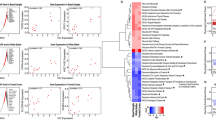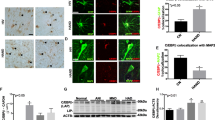Abstract
HIV-associated neurocognitive disorders are common in HIV-infected individuals, even in the combination antiretroviral therapy (c-ART) era. Several mechanisms are involved in neuronal damage, including chronic inflammation immune activation. Mammalian 2′-5′-oligoadenylate synthetase (OAS) genes are produced in response to interferon (IFN), mainly by monocytes, and exert their antiviral functions by activation of RNase L that degrades viral and cellular RNAs. In this study, we aimed at exploring OAS gene family RNA expression in simian immunodeficiency virus encephalitis (SIVE), in HIV-associated neurocognitive disorders (HAND), and in HIV-associate dementia (HAD). We analyzed three microarray datasets obtained from the NCBI in order to assess the expression levels of OAS gene family network in brain biopsies of macaques with SIVE vs uninfected animals, as well as post-mortem brain of individuals with HAND (on or off ART) vs uninfected controls and three brain regions of HIV-infected individuals with both neurocognitive impairment (HAD) and encephalitis (HIVE). All OAS genes were upregulated both in SIVE and in HAND. OAS expression was significantly higher in high-viremic individuals; increased expression levels persisted in cART subjects when compared to healthy controls. OAS gene network analysis showed that several genes belonging to the type I IFN pathway, especially CXCL10 and IFIT3, were similarly upregulated in SIVE/HAND. Furthermore, we identified a significant upregulation of OAS gene family RNA expression in basal ganglia, white matter, and frontal cortex of HIV-1, HAD, and HAD/HIVE patients compared to healthy subjects. OAS gene family expression is increased in brain sections from individuals with HAND, HAD, and HIVE as well as macaques with SIVE. OAS family expression is likely to be induced by IFN as a consequence of viral replication in the CNS. Its long-term upregulation may contribute to the chronic inflammatory status and neurocognitive impairment we still observe in virologically suppressed individuals on c-ART.






Similar content being viewed by others
Abbreviations
- c-ART:
-
Combination antiretroviral therapy
- HAART:
-
Highly active anti-retroviral therapy
- AIDS:
-
Acquired immune deficiency syndrome
- CNS:
-
Central nervous system
- HIV:
-
Human immunodeficiency virus
- SIV:
-
HIV/simian immunodeficiency virus
- SIVE:
-
Simian immunodeficiency virus encephalitis
- HAND:
-
HIV-associated neurocognitive disorders
- HAD:
-
HIV-infected with neurocognitive impairment or HIV associate dementia
- ANI:
-
Asymptomatic neurocognitive impairment
- HIVE:
-
HIV encephalitis
- BBB:
-
Blood-brain barrier
- CSF:
-
Cerebrospinal fluid
- CXCL10:
-
C-X-C motif chemokine 10
- FDR:
-
False discovery rate
- IFIT3:
-
Interferon-induced protein with tetratricopeptide repeats 3
- OAS1:
-
2′-5′-Oligoadenylate synthetase 1
- OAS2:
-
2′-5′-Oligoadenylate synthetase 2
- OAS3:
-
2′-5′-Oligoadenylate synthetase 3
- OASL:
-
2′-5′-Oligoadenylate synthetase-like
- MeV:
-
MultiExperiment Viewer
- IQR:
-
Interquartile range
- BVL:
-
Brain viral load
References
Scarpino M, Pinzone MR, Di Rosa M, Madeddu G, Foca E, Martellotta F, Schioppa O, Ceccarelli G et al (2013) Kidney disease in HIV-infected patients. European review for medical and pharmacological sciences 17(19):2660–2667
Castronuovo D, Cacopardo B, Pinzone MR, Di Rosa M, Martellotta F, Schioppa O, Moreno S, Nunnari G (2013) Bone disease in the setting of HIV infection: update and review of the literature. European review for medical and pharmacological sciences 17(18):2413–2419
Pinzone MR, Berretta M, Cacopardo B, Nunnari G (2015) Epstein-barr virus- and Kaposi sarcoma-associated herpesvirus-related malignancies in the setting of human immunodeficiency virus infection. Semin Oncol 42(2):258–271. doi:10.1053/j.seminoncol.2014.12.026
Pinzone MR, Fiorica F, Di Rosa M, Malaguarnera G, Malaguarnera L, Cacopardo B, Zanghi G, Nunnari G (2012) Non-AIDS-defining cancers among HIV-infected people. European review for medical and pharmacological sciences 16(10):1377–1388
Nunnari G, Berretta M, Pinzone MR, Di Rosa M, Berretta S, Cunsolo G, Malaguarnera M, Cosentino S et al (2012) Hepatocellular carcinoma in HIV positive patients. European review for medical and pharmacological sciences 16(9):1257–1270
Heaton RK, Clifford DB, Franklin DR Jr, Woods SP, Ake C, Vaida F, Ellis RJ, Letendre SL et al (2010) HIV-associated neurocognitive disorders persist in the era of potent antiretroviral therapy: CHARTER Study. Neurology 75(23):2087–2096. doi:10.1212/WNL.0b013e318200d727
Hong S, Banks WA (2015) Role of the immune system in HIV-associated neuroinflammation and neurocognitive implications. Brain Behav Immun 45:1–12. doi:10.1016/j.bbi.2014.10.008
Airoldi M, Bandera A, Trabattoni D, Tagliabue B, Arosio B, Soria A, Rainone V, Lapadula G et al (2012) Neurocognitive impairment in HIV-infected naive patients with advanced disease: the role of virus and intrathecal immune activation. Clinical & developmental immunology 2012:467154. doi:10.1155/2012/467154
Kristiansen H, Gad HH, Eskildsen-Larsen S, Despres P, Hartmann R (2011) The oligoadenylate synthetase family: an ancient protein family with multiple antiviral activities. Journal of interferon & cytokine research : the official journal of the International Society for Interferon and Cytokine Research 31(1):41–47. doi:10.1089/jir.2010.0107
Fagone P, Nunnari G, Lazzara F, Longo A, Cambria D, Distefano G, Palumbo M, Nicoletti F et al (2016) Induction of OAS gene family in HIV monocyte infected patients with high and low viral load. Antivir Res 131:66–73. doi:10.1016/j.antiviral.2016.04.009
Gersten M, Alirezaei M, Marcondes MC, Flynn C, Ravasi T, Ideker T, Fox HS (2009) An integrated systems analysis implicates EGR1 downregulation in simian immunodeficiency virus encephalitis-induced neural dysfunction. The Journal of neuroscience : the official journal of the Society for Neuroscience 29(40):12467–12476. doi:10.1523/JNEUROSCI.3180-09.2009
Borjabad A, Morgello S, Chao W, Kim SY, Brooks AI, Murray J, Potash MJ, Volsky DJ (2011) Significant effects of antiretroviral therapy on global gene expression in brain tissues of patients with HIV-1-associated neurocognitive disorders. PLoS Pathog 7(9):e1002213. doi:10.1371/journal.ppat.1002213
Gelman BB, Chen T, Lisinicchia JG, Soukup VM, Carmical JR, Starkey JM, Masliah E, Commins DL et al (2012) The National NeuroAIDS Tissue Consortium brain gene array: two types of HIV-associated neurocognitive impairment. PLoS One 7(9):e46178. doi:10.1371/journal.pone.0046178
Szklarczyk D, Franceschini A, Wyder S, Forslund K, Heller D, Huerta-Cepas J, Simonovic M, Roth A et al (2015) STRING v10: protein-protein interaction networks, integrated over the tree of life. Nucleic Acids Res 43(Database issue):D447–D452. doi:10.1093/nar/gku1003
Greene CS, Krishnan A, Wong AK, Ricciotti E, Zelaya RA, Himmelstein DS, Zhang R, Hartmann BM et al (2015) Understanding multicellular function and disease with human tissue-specific networks. Nat Genet 47(6):569–576. doi:10.1038/ng.3259
Pathan M, Keerthikumar S, Ang CS, Gangoda L, Quek CY, Williamson NA, Mouradov D, Sieber OM et al (2015) FunRich: an open access standalone functional enrichment and interaction network analysis tool. Proteomics 15(15):2597–2601. doi:10.1002/pmic.201400515
Maneglier B, Rogez-Kreuz C, Dereuddre-Bosquet N, Martal J, Devillier P, Dormont D, Clayette P (2008) Anti-HIV effects of IFN-tau in human macrophages: role of cellular antiviral factors and interleukin-6. Pathologie-biologie 56(7–8):492–503. doi:10.1016/j.patbio.2008.06.002
Durudas A, Chen HL, Gasper MA, Sundaravaradan V, Milush JM, Silvestri G, Johnson W, Giavedoni LD et al (2011) Differential innate immune responses to low or high dose oral SIV challenge in rhesus macaques. Curr HIV Res 9(5):276–288
Durudas A, Milush JM, Chen HL, Engram JC, Silvestri G, Sodora DL (2009) Elevated levels of innate immune modulators in lymph nodes and blood are associated with more-rapid disease progression in simian immunodeficiency virus-infected monkeys. J Virol 83(23):12229–12240. doi:10.1128/JVI.01311-09
Sarkar S, Kalia V, Murphey-Corb M, Montelaro RC, Reinhart TA (2003) Expression of IFN-gamma induced CXCR3 agonist chemokines and compartmentalization of CXCR3+ cells in the periphery and lymph nodes of rhesus macaques during simian immunodeficiency virus infection and acquired immunodeficiency syndrome. J Med Primatol 32(4–5):247–264
Stacey AR, Norris PJ, Qin L, Haygreen EA, Taylor E, Heitman J, Lebedeva M, DeCamp A et al (2009) Induction of a striking systemic cytokine cascade prior to peak viremia in acute human immunodeficiency virus type 1 infection, in contrast to more modest and delayed responses in acute hepatitis B and C virus infections. J Virol 83(8):3719–3733. doi:10.1128/JVI.01844-08
Cinque P, Bestetti A, Marenzi R, Sala S, Gisslen M, Hagberg L, Price RW (2005) Cerebrospinal fluid interferon-gamma-inducible protein 10 (IP-10, CXCL10) in HIV-1 infection. J Neuroimmunol 168(1–2):154–163. doi:10.1016/j.jneuroim.2005.07.002
Read SE, Williams BR, Coates RA, Evans WK, Fanning MM, Garvey MB, Shepherd FA (1985) Elevated levels of interferon-induced 2'-5' oligoadenylate synthetase in generalized persistent lymphadenopathy and the acquired immunodeficiency syndrome. The Journal of infectious diseases 152(3):466–472
Pulliam L (2014) Cognitive consequences of a sustained monocyte type 1 IFN response in HIV-1 infection. Curr HIV Res 12(2):77–84
Pulliam L, Gascon R, Stubblebine M, McGuire D, McGrath MS (1997) Unique monocyte subset in patients with AIDS dementia. Lancet 349(9053):692–695. doi:10.1016/S0140-6736(96)10178-1
Kalter DC, Nakamura M, Turpin JA, Baca LM, Hoover DL, Dieffenbach C, Ralph P, Gendelman HE et al (1991) Enhanced HIV replication in macrophage colony-stimulating factor-treated monocytes. J Immunol 146(1):298–306
Author information
Authors and Affiliations
Corresponding author
Ethics declarations
Conflict of Interest
The authors declare that they have no conflict of interest.
Electronic supplementary material

Supplementary Figure 1
(GIF 14Â kb)

Supplementary Figure 2
(GIF 43Â kb)

Supplementary Figure 3
(GIF 276Â kb)

Supplementary Figure 4
(GIF 60Â kb)

Supplementary Figure 5
(GIF 82Â kb)
Supplementary Figure 6
(TIFF 104Â kb)
Supplementary Table 1
(XLSX 7355Â kb)
Rights and permissions
About this article
Cite this article
Sanfilippo, C., Pinzone, M., Cambria, D. et al. OAS Gene Family Expression Is Associated with HIV-Related Neurocognitive Disorders. Mol Neurobiol 55, 1905–1914 (2018). https://doi.org/10.1007/s12035-017-0460-3
Received:
Accepted:
Published:
Issue Date:
DOI: https://doi.org/10.1007/s12035-017-0460-3




